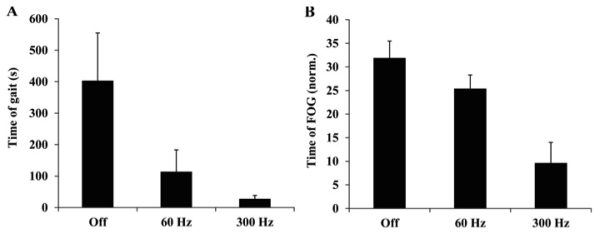Session Information
Date: Monday, June 20, 2016
Session Title: Surgical therapy: Parkinson's disease
Session Time: 12:30pm-2:00pm
Location: Exhibit Hall located in Hall B, Level 2
Objective: The aim of our study was to evaluate further the potential role of spinal cord stimulation (SCS) as a treatment for gait disturbances and FOG in PD.
Background: Gait disturbances and freezing of gait (FOG) are common in Parkinson’s disease (PD), often leading to institutionalization and a loss of independence in the advanced stages of the disease. Deep brain stimulation (DBS) and levodopatherapy ameliorate cardinal motor symptoms in PD but their effects on FOG and gait disturbance are not sustained at long-term. Experimental studies suggest a positive effect of spinal cord stimulation over locomotion.
Methods: Two elderly patients from the Hospital das Clinicas of the School of Medicine of University of Sao Paulo underwent SCS surgery. Paddle electrodes with three columns of 5, 6 and 5 contacts were implanted in the thoracic region (T2 to T4). Changes in gait were measured after the SCS surgery in double blind assessments conducted with SCS at Off stimulation, 60Hz and 300Hz in different days. All evaluations occurred while patients were receiving DBS without antiparkisonian medications. Their gait was assessed through accelerometers placed on legs, wrists, lumbar region and head. Each patient performed a 10 meters walking task three times in each stimulation condition. Objective measures based on frequency characteristics of vertical acceleration of the lumbar region derived from the accelerometers were used to calculate the time of FOG during gait.
Results: The  shows the average and standard deviation of the gait duration (A) and time of FOG (B) during the 10 meters task from the accelerometers of the legs. Results showed that the time of gait decreased dramatically from Off stimulation to 60 Hz and 300 Hz. It is worth noting that the occurrence of FOG also decreased greatly from Off stimulation to 300 Hz.
shows the average and standard deviation of the gait duration (A) and time of FOG (B) during the 10 meters task from the accelerometers of the legs. Results showed that the time of gait decreased dramatically from Off stimulation to 60 Hz and 300 Hz. It is worth noting that the occurrence of FOG also decreased greatly from Off stimulation to 300 Hz.
Conclusions: The data obtained from the instrumented gait evidenced that SCS stimulation improved gait parameters of the two patients assessed, mainly during 300Hz stimulation. Spinal cord stimulation seems to be an efficient alternative treatment for gait disorders in patients with PD. However, more prospective studies with SCS including instrumented gait analysis is required to better understand the effects of the stimulation on motor disorders in patients with PD.
To cite this abstract in AMA style:
C.O. Souza, C.P. Souza, A.L. Pardini, D. Boari, L.A. Teixeira, E.R. Barbosa, E.T. Fonoff. Spinal cord stimulation improves freezing of gait in Parkinson’s disease in chronic implanted stn-dbs patients: A case report [abstract]. Mov Disord. 2016; 31 (suppl 2). https://www.mdsabstracts.org/abstract/spinal-cord-stimulation-improves-freezing-of-gait-in-parkinsons-disease-in-chronic-implanted-stn-dbs-patients-a-case-report/. Accessed December 23, 2025.« Back to 2016 International Congress
MDS Abstracts - https://www.mdsabstracts.org/abstract/spinal-cord-stimulation-improves-freezing-of-gait-in-parkinsons-disease-in-chronic-implanted-stn-dbs-patients-a-case-report/
